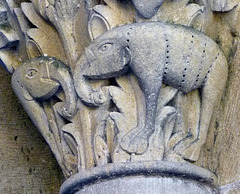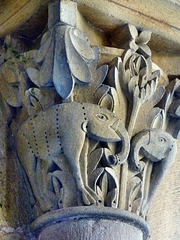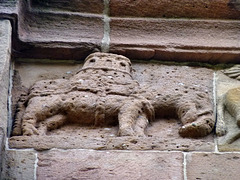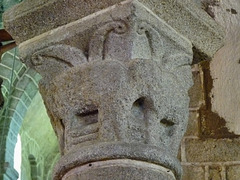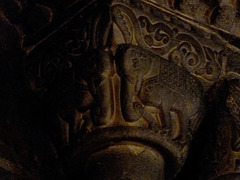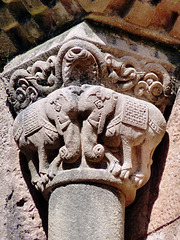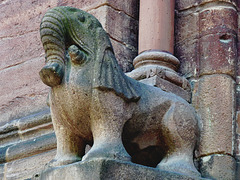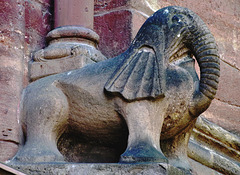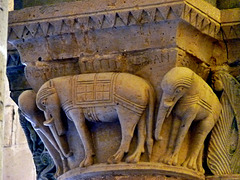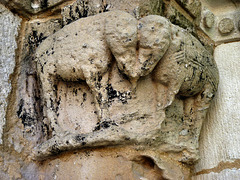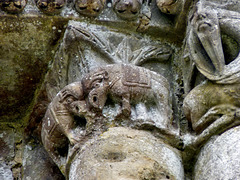
Medieval Elephants
It is known, that only three elephants have been in Europe between 800 and 1300.
"Abul Abbas" (+810) owned by Charlemagne, a present from Harun al-Rashid.
The so called "Cremona-elephant" owned by Frederik II in 1229, a present from Al-Kamil al-Malik.
The elephant brought to France by
Louis IX (Saint Louis) in 1255 on his return from the 6th cruisade and presented to Henry III. This elephant…
(read more)
Perrecy-les-Forges - Saint-Pierre-et-Saint-Benoît
| |
|
The church of the former Priory Saint-Pierre-et-Saint-Benoît is now the parish church of the village. When I visited Perrecy-les-Forges in April 2011 I had the impression, that the church and the museum were locked since years.
Charles Martel, grandfather of Charlemagne and leader of the frankish armee in the Battle of Tours (732), gave the Perrecey estate to his brother Childebrand as a gift to thank him for defeating the Sarascens in the valleys of the Rhone and the Saône in 732. Childebrands heirs bequeated it to the abbey of Saint-Benoît-sur-Loire.
First monks settled here 880/885. Some parts of the westwork may date back to the 9th century. 1020/1030 a romanesque basilica was constructed here. 1120/1130 the large narthex was added, which is - a unique masterpiece.
This capital - for me - is the most interesting in Perrecy-les-Forges. Decades ago during my first year at university I wrote an essay, dealing with the subject "Medieval Elephants". There were only three elephants during medieval times:
Abul Abbas, a present from Harun al Raschid to Charlemagne. Abul Abbas reached Aix La Chapelle in 802 died 810 after swimming in the Rhine.
The Cremona-elephant was a present from Al Kamil to Frederik II in 1229.
The third elephant was brought to Europe by Louis IX (Saint Louis) in 1255. It was given to Henry III and died in London 1258.
There was not a single elephant in Europe between 810 and 1229, and this capital was carved 1120/1130. - It may be, that the carver of this "exotic" capital, was a well travelled person, but I doubt it.
It is a phantastic carving designed completely out of rumours about a giant animal living far behind the horiziont.
The animal would have a large nose or trunk, long teeth - and totally "uncommon" feet. Over the distances, the size of the ears got lost and the feet got fanshaped, but that is all details. Actually these elephants are pretty precise! I have built up a collection of medivale elephants, if you want to see more, just follow the link:
www.flickr.com/photos/martin-m-miles/galleries/7215762494...
Perrecy-les-Forges - Saint-Pierre-et-Saint-Benoît
| |
|
The church of the former Priory Saint-Pierre-et-Saint-Benoît is now the parish church of the village. When I visited Perrecy-les-Forges in April 2011 I had the impression, that the church and the museum were locked since years.
Charles Martel, grandfather of Charlemagne and leader of the frankish armee in the Battle of Tours (732), gave the Perrecey estate to his brother Childebrand as a gift to thank him for defeating the Sarascens in the valleys of the Rhone and the Saône in 732. Childebrands heirs bequeated it to the abbey of Saint-Benoît-sur-Loire.
First monks settled here 880/885. Some parts of the westwork may date back to the 9th century. 1020/1030 a romanesque basilica was constructed here. 1120/1130 the large narthex was added, which is - a unique masterpiece.
This capital - for me - is the most interesting in Perrecy-les-Forges. Decades ago during my first year at university I wrote an essay, dealing with the subject "Medieval Elephants". There were only three elephants during medieval times:
Abul Abbas, a present from Harun al Raschid to Charlemagne. Abul Abbas reached Aix La Chapelle in 802 died 810 after swimming in the Rhine.
The Cremona-elephant was a present from Al Kamil to Frederik II in 1229.
The third elephant was brought to Europe by Louis IX (Saint Louis) in 1255. It was given to Henry III and died in London 1258.
There was not a single elephant in Europe between 810 and 1229, and this capital was carved 1120/1130. - It may be, that the carver of this "exotic" capital, was a well travelled person, but I doubt it.
It is a phantastic carving designed completely out of rumours about a giant animal living far behind the horiziont.
The animal would have a large nose or trunk, long teeth - and totally "uncommon" feet. Over the distances, the size of the ears got lost and the feet got fanshaped, but that is all details. Actually these elephants are pretty precise! I have built up a collection of medivale elephants, if you want to see more, just follow the link:
www.flickr.com/photos/martin-m-miles/galleries/7215762494.. .
Perrecy-les-Forges - Saint-Pierre-et-Saint-Benoît
| |
|
The church of the former Priory Saint-Pierre-et-Saint-Benoît is now the parish church of the village. When I visited Perrecy-les-Forges in April 2011 I had the impression, that the church and the museum were locked since years.
Charles Martel, grandfather of Charlemagne and leader of the frankish armee in the Battle of Tours (732), gave the Perrecey estate to his brother Childebrand as a gift to thank him for defeating the Sarascens in the valleys of the Rhone and the Saône in 732. Childebrands heirs bequeated it to the abbey of Saint-Benoît-sur-Loire.
First monks settled here 880/885. Some parts of the westwork may date back to the 9th century. 1020/1030 a romanesque basilica was constructed here. 1120/1130 the large narthex was added, which is - a unique masterpiece.
This capital - for me - is the most interesting in Perrecy-les-Forges. Decades ago during my first year at university I wrote an essay, dealing with the subject "Medieval Elephants". There were only three elephants during medieval times:
Abul Abbas, a present from Harun al Raschid to Charlemagne. Abul Abbas reached Aix La Chapelle in 802 died 810 after swimming in the Rhine.
The Cremona-elephant was a present from Al Kamil to Frederik II in 1229.
The third elephant was brought to Europe by Louis IX (Saint Louis) in 1255. It was given to Henry III and died in London 1258.
There was not a single elephant in Europe between 810 and 1229, and this capital was carved 1120/1130. - It may be, that the carver of this "exotic" capital, was a well travelled person, but I doubt it.
It is a phantastic carving designed completely out of rumours about a giant animal living far behind the horiziont.
The animal would have a large nose or trunk, long teeth - and totally "uncommon" feet. Over the distances, the size of the ears got lost and the feet got fanshaped, but that is all details. Actually these elephants are pretty precise! I have built up a collection of medivale elephants, if you want to see more, just follow the link:
www.flickr.com/photos/martin-m-miles/galleries/7215762494.. .
Andlau - Saints-Pierre-et-Paul
| |
|
Richardis, wife of Charles III (aka "Charles the Fat") and so "Holy Roman Empress", founded the abbey in Andlau ca 880. Later she lived here (as the abbess). She was known for her piety and so she was canonised, when Pope Leo IX paid a visit to the abbey in 1049.
Another frame of the frieze in Andlau.
An elephant, a griffin and a man holding two hunting dogs.
The elephant is carved pretty precise - and that is pretty strange. This carvings in Andlau are dated 1130/1150, where did the carver obtain his obviously precise anatomical knowledge about the elephant?
There were only three elephants in Europe in the medieval days.
"Abul Abbas" (+810) owned by Charlemagne, - the "Cremona-elephant" owned by Frederik II in 1229 - and one owned by Louis IX in 1255 and given to Henry III later. This one died in London 1258.
May these carving be more than 100 years younger - and show either the "Cremona"- or the "Saint Louis"-elephant? I just do not know. Please compare this elephant to the many other medieval carvings and drawings I have collected here:
www.flickr.com/photos/martin-m-miles/galleries/7215762494...
The griffin, holding an animal down with his four claws, is nicely carved. The hunter with a spear, holding two hunting dogs on a leash, seems to be connected to the "deer hunt", as that was framed (to the left) by a similar hunter with a spear.
Andlau - Saints-Pierre-et-Paul
| |
|
Richardis, wife of Charles III (aka "Charles the Fat") and so "Holy Roman Empress", founded the abbey in Andlau ca 880. Later she lived here (as the abbess). She was known for her piety and so she was canonised, when Pope Leo IX paid a visit to the abbey in 1049.
A close-up of the "Andlau-elephant" (seen on the pic before).
The elephant is carved pretty precise - and that is pretty strange.
This carvings in Andlau are dated 1130/1150, where did the carver obtain his obviously precise anatomical knowledge about the elephant?
There were only three elephants in Europe in the medieval days.
"Abul Abbas" (+810) owned by Charlemagne, - the "Cremona-elephant" owned by Frederik II in 1229 - and one owned by Louis IX in 1255 and given to Henry III later. This one died in London 1258.
May these carving be more than 100 years younger - and show either the "Cremona"- or the "Saint Louis"-elephant? I just do not know. Please compare this elephant to the many other medieval carvings and drawings I have collected here:
www.flickr.com/photos/martin-m-miles/galleries/7215762494...
Châtel-Montagne - Notre-Dame
| |
|
In 1082 some Seigneur Dalmas and his wife Étiennette gave all the properties they owned in "Castrumin Montanis", including a church, to Cluny. This legal act was important enough to get an official approval from Pope Urban II in 1095.
A priory was set up - and a small church was erected. Parts of this church can still be found in the church seen here, built 1100 - 1200. The priory never really flourished, the community of monks was small - and already from 1462 on, the church was used as a parish church.
The church is quite large for a remote village of a population well under 500 (today). When it was planned during the boom of pilgrimage to Santiago de Compostella, Châtel-Montagne was ideally placed on one of the many "Chemin de St-Jacques" in France.
As seen already, not only the architectoral structure is built from granite, the carved capitals are carved from this extrem hard stone as well. So they cannot be that fine and detailled as sandstone-carvings can be. They do have a certain kind of roughness.
Bernard Craplet, author of "Auvergne romain", the most helpfull book, when touring the Auvergne, sees in this capital "horses (or elephants)". I´m not sure. These could be nearly any large four-legged animal. But as elephants are pretty rare, I´ll add them to my still small "Medieval Elephants Set".
Sant Joan de les Abadesses - Monastery
| |
|
The monastery was founded in 885 by Wilfred the Hairy as one of the first nunneries in Catalonia. First abbess here was his daughter Emma. At that time her brother Radulf was abbot in nearby Ripoll, where Wilfred had founded a monastery as well. A family business!
The church of the nunnery was consecrated in 887, but already in 1017, by request of Bernard I of Besalú, a papal bull suppressed the nunnery. Bernard then established a community of monks. In 1114 Augustinian canons took possession of the monastery, ruled by local abbots until 1484. In 1592 the monastery was secularized and converted into a simple collegiate that was given up in 1856.
The church has a single nave and a wide transept. The transept opens to to five apses. Many carved capitals can be found in the dim building - and Wilfred the Hairy´s "crown" is on display here.
Another surprise, as not only the beardpullers are outside and inside the church, the elephants as well. These elephants are really identical to the cousins outside the apse.
Sant Joan de les Abadesses - Monastery
| |
|
The monastery was founded in 885 by Wilfred the Hairy as one of the first nunneries in Catalonia. First abbess here was his daughter Emma. At that time her brother Radulf was abbot in nearby Ripoll, where Wilfred had founded a monastery as well. A family business!
The church of the nunnery was consecrated in 887, but already in 1017, by request of Bernard I of Besalú, a papal bull suppressed the nunnery. Bernard then established a community of monks. In 1114 Augustinian canons took possession of the monastery, ruled by local abbots until 1484. In 1592 the monastery was secularized and converted into a simple collegiate that was given up in 1856.
The current church dates back to the 12th century, though it got largely restored after an earthquake in 1428. It has a single nave, a wide transept and five apses.
A capital of the extraordenary decorated central apse depicts elephants, a very rare species on medieval capitals. The elephants, seen here, are pretty "exact" and realistic. The ratio body/head and head/trunk is very well, only the ears are missing and the feet look strange.
The first elephant, who is recorded in Europe (after Roman times), was Abul Abbas, presented to Charlemagne by Harun al-Rashid. Abul Abbas reached Aix-la-Chapelle in 802.
The second elephant recorded is the "Cremona Elephant", presented by Sultan Al-Kamil to Frederick II, Holy Roman Emperor, in 1229.
In 1255 Louis IX of France (aka "Saint Louis") brought an elephant home from the 6th cruisade. This one was given to Henry III of England and died in London in 1258.
So during the 12th century, when this capital was carved, there was no elephant in Europe, what has led to the speculation, to see these elephants as carved by moorish carvers, who may have had different experiences/backgrounds.
Basel - Muenster
| |
|
The first (carolingian) church here is named "Haito Muenster", as Bishop Haito ( as well abbot of the important Reichenau Abbey) had comissioned it. It was completed around 825.
The foundations of these structure were reused, when the so called "Heinrich Muenster" was built just after 1000, sponsored and named after Emperor Heinrich II (Henry II) of the Ottonian dynasty. Already in 1019 this church got consecrated.
The Muenster seen today is the third large church, erected 1180 - 1220/30. The late romanesque church had five towers, that all got destroyed (with most vaultings) in 1356 during the worst earthquake ever recorded in Central Europe. Modern seismologists estimate a magnitude of 7.1.
The rebuilding of the Muenster was led by Johannes Parler, who at the same time was employed for building the Freiburg Muenster. So there are a lot of parallels between these two Muensters, only 70 kms apart.
About 1500 the Muenster was finally completed in a combination of late romanesque and gothic style. The restauration process started about 400 years later. Pollution caused a lot of damage and meanwhile many of the carvings outside the church have been replaced by copies. So many of the details seen on the shots may be - copies.
A more detailed shot of the left elephant. This one does have (small) tusks - and so may be male. The trunk is pretty precise and now in a different position, proving the flexibility.
Basel - Muenster
| |
|
|
The first (carolingian) church here is named "Haito Muenster", as Bishop Haito ( as well abbot of the important Reichenau Abbey) had comissioned it. It was completed around 825.
The foundations of these structure were reused, when the so called "Heinrich Muenster" was built just after 1000, sponsored and named after Emperor Heinrich II (Henry II) of the Ottonian dynasty. Already in 1019 this church got consecrated.
The Muenster seen today is the third large church, erected 1180 - 1220/30. The late romanesque church had five towers, that all got destroyed (with most vaultings) in 1356 during the worst earthquake ever recorded in Central Europe. Modern seismologists estimate a magnitude of 7.1.
The rebuilding of the Muenster was led by Johannes Parler, who at the same time was employed for building the Freiburg Muenster. So there are a lot of parallels between these two Muensters, only 70 kms apart.
About 1500 the Muenster was finally completed in a combination of late romanesque and gothic style. The restauration process started about 400 years later. Pollution caused a lot of damage and meanwhile many of the carvings outside the church have been replaced by copies. So many of the details seen on the shots may be - copies.
A more detailed shot of the right elephant. This one has no tusks - and so may be female. The trunk is pretty precise.
Basel - Muenster
| |
|
|
The first (carolingian) church here is named "Haito Muenster", as Bishop Haito ( as well abbot of the important Reichenau Abbey) had comissioned it. It was completed around 825.
The foundations of these structure were reused, when the so called "Heinrich Muenster" was built just after 1000, sponsored and named after Emperor Heinrich II (Henry II) of the Ottonian dynasty. Already in 1019 this church got consecrated.
The Muenster seen today is the third large church, erected 1180 - 1220/30. The late romanesque church had five towers, that all got destroyed (with most vaultings) in 1356 during the worst earthquake ever recorded in Central Europe. Modern seismologists estimate a magnitude of 7.1.
The rebuilding of the Muenster was led by Johannes Parler, who at the same time was employed for building the Freiburg Muenster. So there are a lot of parallels between these two Muensters, only 70 kms apart.
About 1500 the Muenster was finally completed in a combination of late romanesque and gothic style. The restauration process started about 400 years later. Pollution caused a lot of damage and meanwhile many of the carvings outside the church have been replaced by copies. So many of the details seen on the shots may be - copies.
A pair of elephants hold the pillars, that flank the romanesque window. Like most medieval elephants these two seem the result of an artistic imagination, based on a faint rumour. Large ears, a trunk, strong legs to support the heavy weight. The left one even has tusks.
Note the frieze, I´ll upload shots of that later..
Boí - Sant Joan de Boí
| |
|
The Vall de Boí is a small valley with a complex medieval history with many political moves, due to the strategic position (there are still eight castles) and the silver that was mined here. Actually the history is too complex, to boil it down to a few lines, so I will not try.
The valley is famous for its for its nine Romanesque churches. It was designated as a World Heritage Site by UNESCO in 2000 and it is claimed to have the "densest concentration of Romanesque architecture in Europe". I am not sure, what density here really means, as Rome and Cologne have a very rich Romanesque architecture as well - but a way larger population.
The village of Boí gives its name to the valley. It has a population of about 200 - and has the wonderful parish church Sant Joan de Boí. The church is a three nave-basilica, with a rectangular central apse and two semicircular apsidioles. The church suffered a major fire in the 13th century.
Sant Joan de Boí is known for it´s mural paintings. The originals are kept (like most frescoes of the valley´s churches) in the "Museu d'Art de Catalunya" in Barcelona, but I was told that the copies, that now cover the walls are pretty precise.
Once (1100) the walls were covered with mural paintings, but only a few survived incomplete.
An oLIFAnt!
The elephant lost it´s trunk over the time. Similar to the group of grey animals just seen, the tusks protrude like horns. As neither the artist, nor one of the onlookers had ever seen an elephant, this small slip is absolutely forgivable.
Aulnay - Saint-Pierre
| |
|
"Saint-Pierre d'Aulnay" is a church outside of Aulnay, in the center of an old graveyard. The setting has not changed for centuries. For the pilgrims of the 12th century this church was a major halt - and it still is for all the tourists...
A predecessing church „Saint-Pierre-de-la-Tour“ had been here, that, when the pilgrimage to Santiago de Compostella got more and more popular, was obviously to small, as Aulnay was conveniently situated between Poitiers and Saintes on the Via Turonensis. A new, larger church was needed, so the place was handed over to the chapter of the cathedral in Poitiers. The canons then probably planned this church, that was erected from about 1130/1140 on.
"Saint-Pierre d'Aulnay" is a gem of the "style saintongeais". For Peter Strafford ("Romanesque Churches Of France") this is "one of the best examples of late Romanesque architecture in what used to be Aquitaine".
This capital - for me - is the most interesting in Aulnay, as three elephants have gathered around the capital. Decades ago during my first year at university I wrote an essay on "Medieval Elephants".
The first elephant, who is recorded in Europe (after Roman times), was Abul Abbas, presented to Charlemagne by Harun al-Rashid. Abul Abbas reached Aix-la-Chapelle in 802.
The second elephant, recorded in medieval times, was the Cremona-elephant, a present from Al Kamil to Frederik II in 1229.
There was no elephant in Europe between 810 and 1229. This carving is based on a myth about a giant animal living "somewhere". To tell the onlookers, what was to be seen, it got an inscription: "Hi(c) sunt elephan(tes)".
The elephants here have tiny ears and very "uncommon" feet, but otherwsie they are pretty "precise".
In case you want to see more medieval elephants, just follow the links:
www.flickr.com/photos/martin-m-miles/sets/72157627646092224/
www.flickr.com/photos/martin-m-miles/galleries/page2/
Surgères - Notre-Dame
| |
|
Notre-Dame de Surgères was erected in the center of a large castle in the 12th century. The fortification, founded in the 9th century as a motte, when the area was raided by the Vikings, then guarded the border of the historical province of Aunis once.
When the church was built a small town had developed around the defence already. Later a small priory and a "hopital" existed, as this was a halt on the Via Turonensis. The pilgrims had a lot to gape here, the facade is stunning 23 meters wide.
Eleanor of Aquitaine married Henry II of England in 1152, so the area changed hands and was ruled by the House of Plantagenet. During the Hundred Years' War Surgères experienced a long period of decline. Louis XI´s troops conquered the town in 1472 and the fortifications got destructed. During that time Notre Dame lost the tower and large parts of the nave, but not the facade!
Six blind arches once flanked the door, five arches above them on "the second floor". There are more than 100 capitals and corbels all over the facade. This seems to be a medieval encyclopedia.
There are even exotic animals like elephants, but not all elephants are so perfectly preserved like the elephants seen on the previos uploads. This couple is really weathered.
Surgères - Notre-Dame
| |
|
Notre-Dame de Surgères was erected in the center of a large castle in the 12th century. The fortification, founded in the 9th century as a motte, when the area was raided by the Vikings, then guarded the border of the historical province of Aunis once.
When the church was built a small town had developed around the defence already. Later a small priory and a "hopital" existed, as this was a halt on the Via Turonensis. The pilgrims had a lot to gape here, the facade is stunning 23 meters wide.
Eleanor of Aquitaine married Henry II of England in 1152, so the area changed hands and was ruled by the House of Plantagenet. During the Hundred Years' War Surgères experienced a long period of decline. Louis XI´s troops conquered the town in 1472 and the fortifications got destructed. During that time Notre Dame lost the tower and large parts of the nave, but not the facade!
Six blind arches once flanked the door, five arches above them on "the second floor". There are more than 100 capitals and corbels all over the facade. This seems to be a medieval encyclopedia.
There are even exotic animals like elephants. This is the same capital as seen on the previous upload, but seen from a different angle.
Surgères - Notre-Dame
| |
|
Notre-Dame de Surgères was erected in the center of a large castle in the 12th century. The fortification, founded in the 9th century as a motte, when the area was raided by the Vikings, then guarded the border of the historical province of Aunis once.
When the church was built a small town had developed around the defence already. Later a small priory and a "hopital" existed, as this was a halt on the Via Turonensis. The pilgrims had a lot to gape here, the facade is stunning 23 meters wide.
Eleanor of Aquitaine married Henry II of England in 1152, so the area changed hands and was ruled by the House of Plantagenet. During the Hundred Years' War Surgères experienced a long period of decline. Louis XI´s troops conquered the town in 1472 and the fortifications got destructed. During that time Notre Dame lost the tower and large parts of the nave, but not the facade!
Six blind arches once flanked the door, five arches above them on "the second floor". There are more than 100 capitals and corbels all over the facade. This seems to be a medieval encyclopedia.
There are even exotic animals like these elephants.
Vouvant - Notre-Dame
| |
|
|
The first church here was founded by William V, Duke of Aquitaine, (aka "William the Great", "Guillaume le Grand") around 1000. He was the son of William "Fierebras" (= iron arm). His daughter Agnes of Poitou was the wife of Henry III, Holy Roman Emperor. As a widow she was known as "Empress Agnes". William the Great was a supporter of the abbey in nearby Maillezais, so it is no surprise, that a priory was founded here.
"Notre Dame" the former church of that priory now serves as parish church of Vouvant, a village of less than a thousand inhabitants. The church was erected within the 11th and 12th century - and very soon after in was completed, the western front got demolished and the nave got enlarged. Obviously a great number of monks and laybrothers lived here at that time, reclaiming land in the swampy "Marais Poitevin".
Just like the abbey in Maillezais, the priory in Vouvant suffered great damages during the 100 Year´s War. It got later looted and ruined during the Wars of Religion. The priory went under - and the church crumbled until the first restaurations were done in 1882. The works ended the same year due to lack of funds. After a recent renovation, the church now is in a good condition.
Somebody had said "As far as I know, there are elephants in Vouvant, but I have ever been there personally." This sentence had changed my schedule in 2011 - and I found out, that the guy was right.
Here are the small Vouvant - elephants. They do not have beaks, they lost a part of their trunks. Actually they are pretty precise, and like most others, they have tiny ears.
Elephants on medieval carvings are a rare species, but there are quite a few in this area (Aulnay, Surgères).
Vouvant - Notre-Dame
| |
|
The first church here was founded by William V, Duke of Aquitaine, (aka "William the Great", "Guillaume le Grand") around 1000. He was the son of William "Fierebras" (= iron arm). His daughter Agnes of Poitou was the wife of Henry III, Holy Roman Emperor. As a widow she was known as "Empress Agnes". William the Great was a supporter of the abbey in nearby Maillezais, so it is no surprise, that a priory was founded here.
"Notre Dame" the former church of that priory now serves as parish church of Vouvant, a village of less than a thousand inhabitants. The church was erected within the 11th and 12th century - and very soon after in was completed, the western front got demolished and the nave got enlarged. Obviously a great number of monks and laybrothers lived here at that time, reclaiming land in the swampy "Marais Poitevin".
Just like the abbey in Maillezais, the priory in Vouvant suffered great damages during the 100 Year´s War. It got later looted and ruined during the Wars of Religion. The priory went under - and the church crumbled until the first restaurations were done in 1882. The works ended the same year due to lack of funds. After a recent renovation, the church now is in a good condition.
The Vouvant - elephants (see previous upload) here from a different angle.
Jump to top
RSS feed- Latest items - Subscribe to the latest items added to this album
- ipernity © 2007-2024
- Help & Contact
|
Club news
|
About ipernity
|
History |
ipernity Club & Prices |
Guide of good conduct
Donate | Group guidelines | Privacy policy | Terms of use | Statutes | In memoria -
Facebook
Twitter


